From Reef Ball
Foundation, Inc.Friday, December 05, 2003
| This press release is web based
because the story here is an enormous and exciting
accomplishment that is actually composed of many
newsworthy component projects. There are blue hyperlinks
to other web resources throughout the release and red
hyperlinks to more in-depth discussion on components of
the project. This project was awarded the Reef Ball Foundation's
2003 Overall Best Project of the
Year. |
St. John's, Antigua. For Immediate
Release.
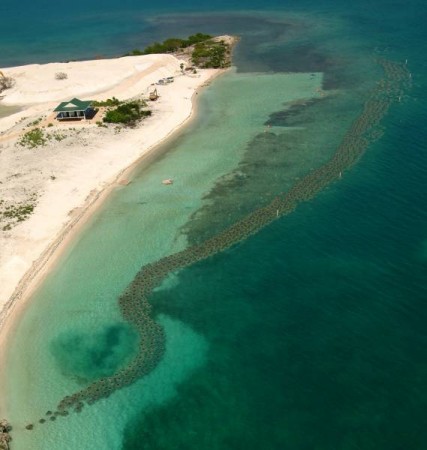
Stanford
Development Company Ltd.(SDC) and the Reef Ball Foundation, Inc.
have created the world's largest fringing breakwater reef
system from over 1,000 designed reef modules.
Constructed in just 2 months and planted with live corals
during the same period, this reef system is an integral part
of the development plan for Maiden Island, Antigua. The
Reef Ball Foundation a 501(c)(3), a publicly supported
charitable organization located in Bradenton, Florida with
headquarters in Atlanta, Georgia was contacted to create the
coral reef breakwater using specially designed Reef Balls
tm, which are prefabricated concrete modules that
are designed to mimic natural reefs. These modules are
constructed with built in adapters for planting live
corals. The Reef Ball Foundation has developed a system
of reproducing live corals, and for this project the
Foundation's expert volunteers created over 5,000 new coral
colonies that were permanently attached to the Reef Balls to
form a natural reef.
During the project, the Reef Ball Foundation
identified other corals in Antigua that were imperiled by
impending construction operations and was able to rescue an
additional 17.5 tons of adult coral colonies, which were
individually stabilized on the Reef Balls and
saved. Because Maiden Island's windward reef
had been destroyed by Luis, a Category 4 hurricane eight years
ago, there was an additional 4.5 tons of loose live rock that
were secured to the Reef Balls so they would not damage the
coral reef in the next hurricane event.

Reef Squid
(Sepioteuthis sepioidea) laid eggs on the Reef Balls
soon after being deployed. The volunteers observed
many squid over several days and most were displaying mating
colors. Above: The male (left) is displaying a white
strip whereas the female (right) is displaying a partial
saddle pattern.
The Reef Ball pictured above has three rescued and
transplanted soft corals colonies (Gorgonians,
large plant looking ones), two rescued and transplanted
Mustard Hill coral colonies (Porites astreoides, the yellow to
brown hard coral in the upper right and at the base behind
it), one stabilized piece of live rock (in the front
hole) and four propagated coral fragments (Acropora
spp.), top of the Reef
Ball). The inch-sized
depressions in the Reef Ball are used for transplanting
additional corals or left to serve as protected resting place
for sea urchins.
Science Helps To Build A Better Reef
The Reef Ball Foundation used the very latest in scientific
techniques to achieve the remarkable feat of restoring a
living reef system. For example, with the help of over
two dozen volunteers from the Antigua St. Johns Chapter of the
Optimist Club, over 500 sea urchins (Echinometra
lucunter) were added to the reef to act as 'janitors' to
keep the corals free from algal overgrowth [Link
to Scientific Study on Sea Urchins and Coral
Health]. Scientifically designed larval lobster
settlement substrates were added to the reef to enhance
survivability of the spiny lobster (Panulirus argus),
an important species in Antigua. Many lobsters have
already been observed on the newly created reef. Dr.
Robin Sherman at Nova Southwestern University in Ft.
Lauderdale previously studied the use of adding rocks to the
center of Reef Balls to create additional complexity and
habitat for small fish. Following the recommendations of
her work, many of the Reef Balls were filled one third full of
rocks and they are exhibiting signs of enhanced juvenile fish
populations. Dr. Richard Spieler and graduate students at
NOVA Southwestern are planning the addition of special
invertebrate enhancers in a proposed scientific control
section of the reef consisting of eight standardized reef
balls and eight with the invertebrate enhancing treatments for
a long term scientific study. According to the latest
management theories of fish stock enhancement, a
fish 'corridor' was designed to help juvenile fish migrate
from shallow to deep waters which ends at a specially designed
reef 'pinnacle' to create a location for fish to
spawn. (Video
of Newly Placed Pinnacle) The Pinnacles are
located so that the prevailing trade winds will move recently
spawned fish larvae back to the protection of the newly built
near shore reef system for protection for
predators. Scientists have also advocated the
creation of genetic coral banks...where different families
from different locations of the same species are conserved in
case of the need for replanting after a hurricane or other
natural disaster when specific families of coral may be lost.
This was done for Staghorn, and Elkhorn corals on this project
because these species are threatened Caribbean wide.
There are numerous proposals for additional long term
monitoring, reef maintenance, public education and reef
protection being considered by SDC for the project.

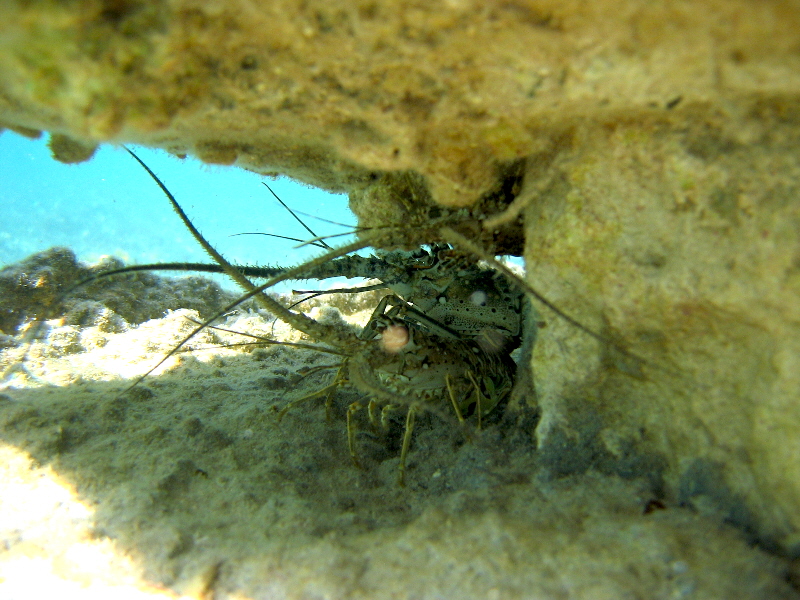
Left:Optimist
Club members gather sea urchins for the new
reef
Right: Spiny Lobsters in 'Layer Cake' style
Reef Ball.
Left: Urchin seeking protection in Reef Ball
depression.
Fish Are Breeding On The New Reef
(Video
of Gray Snappers Schooling to Spawn)
on Maiden Island
at the new reef site near the Pinnacle.
Within weeks of being built, the pinnacle is hosting a
documented spawning event of over 100 large Gray Snappers
(Lutjanus griseus). This is the first documented
formation of a new spawning event. "Starting about two hours
after sunset these fish hover near the ocean bottom. A
dominant fish (in this case a very large Gray Snapper) appears
to entice this group into making rapid ascents to the surface.
The fast and spectacular ascents occur almost daily and are
oftentimes accompanied by an explosion of eggs and milt. "
(Spawning information from AquatechGroup).

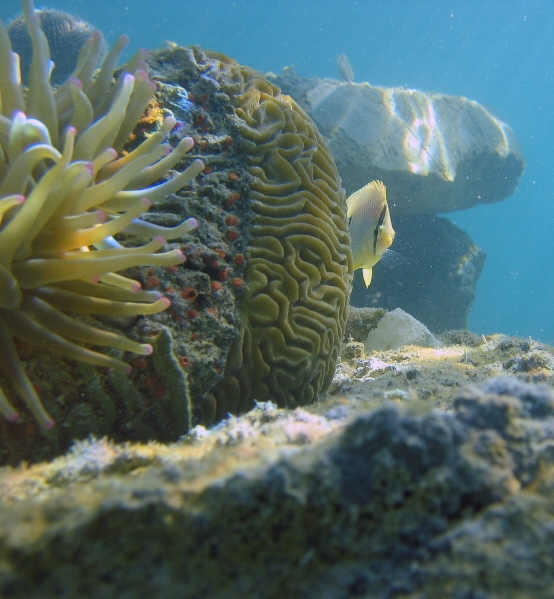
Fish
of 73 different species have already made the new Reef
Balls their home including (left) butterfly fish that need
live corals for food.
Seagrass and Mangroves Complete The New Reef
Seagrass beds and mangrove tree roots are integrated
components of a coral reef system. They serve as nurseries for
many animals that live their adult lives on the reef. One of
the reasons Reef Balls were selected for this project is that
the alternative would have been an armor stone breakwater that
would have impacted thousands of square feet of seagrass beds.
At the suggestion of the Antigua Department of Fisheries, the
Reef Balls were chosen and designed with special open bottoms
to allow sea grasses to flourish around and under the Reef
Balls so that conch (Strombus gigas) habitat was
preserved. Additional measures are being included in the
project to protect seagrass from damage by boat props. For
example, most of Maiden Island will have Reef Balls placed
around near shore shallow seagrass beds as a way to physically
protect them from boat traffic. Scientific
studies have even documented where seagrasses are enhanced by
reefs. In the areas on the Leeward side of
Maiden Island were the seagrass beds are being protected, John
Love, a horticulturalist with Stanford Development Company
Ltd. and The Reef Ball Foundation are teaming up to conduct a
mangrove planting project to further complete the
system. Seedlings will be collected by volunteers and
grown in a nursery until transplanting age, then they will be
planted using specially made small reef balls to protect the
seedlings from storm damage while they take
root.
Learn more about the Mangrove Planting Project
on Maiden Island

Above, 'Mangrove Root Mimic Reef
Balls' will be used near the planted
mangroves to
provide an estuary type reef system. The delicate root mimics
are
re-enforced with fiberglass rebar and will be a host to
a variety of filter
feeders, estuary hardy corals, sponges
and algae.
The combination of all the latest successfully proven
marine restoration techniques in this project has created a
complete ecosystem. The ecosystem restoration is so
successful that The Antigua Department of Fisheries is now
considering protection for the new ecosystem. Such protection
may include the nearby natural reefs, mangroves stands,
seagrass beds, the 'Pinnacle' spawning grounds, and genetic
coral bank reserves to create more abundant fisheries in all
of Antigua and to protect valuable natural
resources.

One can see how the conchs can
move under and around the Reef Balls, but the fish like the
open bottoms too!
Creating New Corals and Saving Threatened Ones: Using
Volunteers From Around The World...
The Reef Ball Foundation activated its Coral Reef
Propagation and Coral Reef Rescue teams which are composed of
hundreds of experts from around the world willing to volunteer
their time, when coral reefs are threatened. For the
Antigua project, over 274 volunteer man-days were used
complete the coral propagation and rescue missions. This
effort included experts from Australia, England, Holland,
Mexico, Curacao, France, Italy, Antigua, Florida, Georgia, New
York, Arizona, Turks and Caicos, Mississippi, Malaysia and
more. Local volunteers from Antigua greatly assisted the
efforts, making this not only the largest reef restoration
effort ever...but also one based largely on
volunteers. The volunteer teams did more than just
transplant and propagate corals...they also did a biological
census, reef clean up, created a genetic coral bank, rescued
imperiled sea life, and educated local Antiguans on the
importance of the coral reefs and how to keep up the health of
the new reef. The volunteer teams documented 73 fish
species, 71 invertebrates spp., 30 corals spp. and 26 algal
spp. (plus a turtle) now on the reef. Every day the
species list continues to grow.


Baseline photos were taken of the coral plugs so the
grow-rates and
survival rates may be documented over
time.
Click to
Enlarge Photo showing range of Hard Coral
Species
Planted
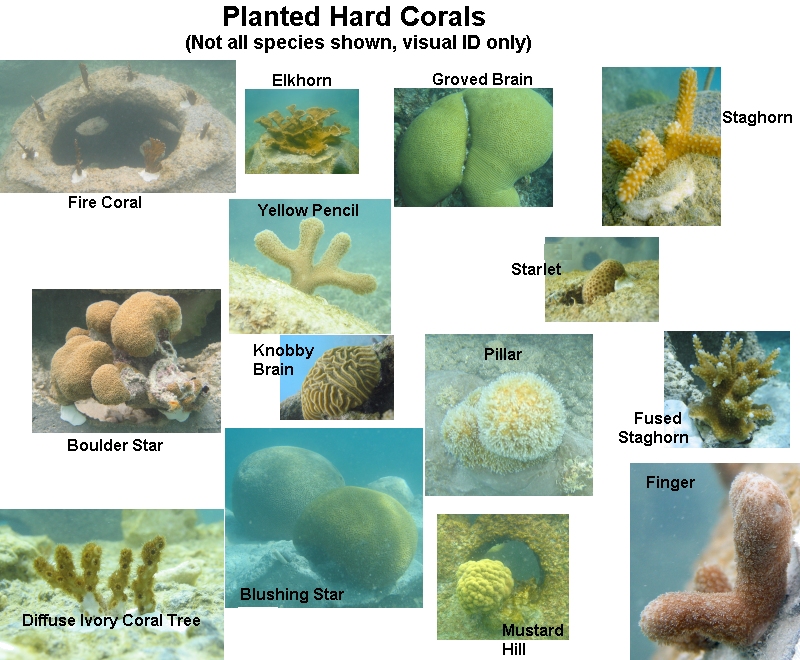
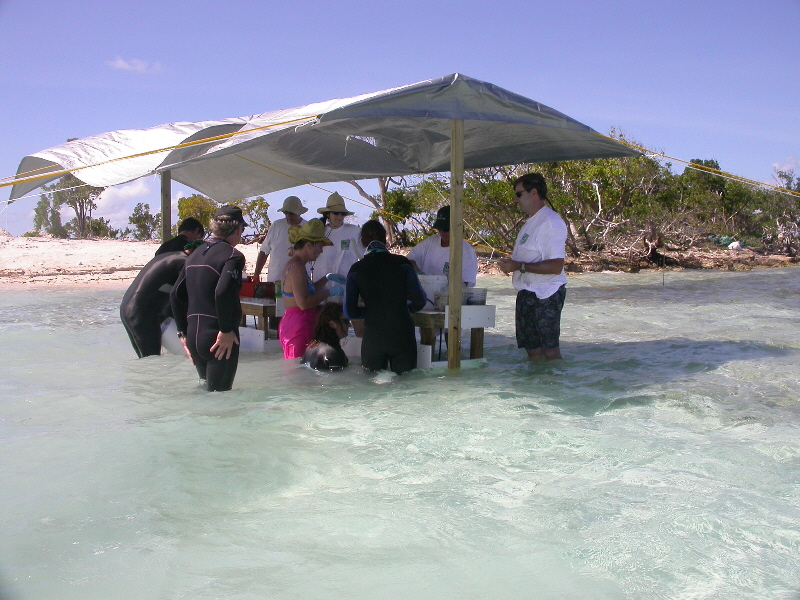
Volunteer coral experts set up
coral propagation tables where corals are
divided and
replanted into special plugs that are later attached to the
Reef Balls.
Learn
about the Reef Ball Foundation Coral Propagation and Coral
Rescue Teams
Snorkeling, Diving and Public Education
Human needs were not forgotten in the construction of the
reef either.
Stanford Development Company Ltd., and
the Reef Ball Foundation created hundreds of yards of
snorkeling and diving trails. These trails provide
visitors a complete tour of the reef to see the wondrous
and abundant reef life now present. The trails are
marked by Reef Balls that have a 12 inch by 12 inch square
markings to make navigation easy, or for possible future
educational signs. There are plans to add mooring buoys
so that anchor drops do not damage the new reef.

A local Antiguan enjoys the
snorkeling trails which include featured areas
such as 'Y'
Canyon Pass, Walk About Pass, Sneak Through Pass, Flint Reef
Trail,
Coral Magic Trail, Elkhorn Alley, Tail Pass and the
Diving Pinnacles. The
Reef Ball Foundation has asked
locals to observe a voluntary 'look but don't
take policy'
until the Fishery Department of Antigua has time to pass a
formal
rule.
Construction & Deployment of the Reef Balls
The Reef Balls themselves were built in Antigua by the
Stanford Development Company Ltd. and assisted by trainers
from Reef Innovations (Reef Innovations is a Reef Ball
authorized contractor based in Orlando, Florida).
Captain Bailey skillfully operated the barge and tug daily and
Vernon Krump provided the construction site, equipment and
labor for Stanford. The construction site had an average
of 100 workers building Reef Balls 24
hours per day, 7 days
per week. Using Reef Ball Foundation and local concrete
experts, a special concrete mix was developed that allowed the
Reef Balls to be cast and deployed within 24 hours while still
retaining the special marine friendly formulations needed to
create a perfect biological reef. The Reef Ball Foundation
uses special additives to make the concrete's pH match that of
natural seawater so that corals and other marine life can grow
on the Reef Balls easily. The outside surfaces of the
Reef Balls are textured so that coral larvae can easily attach
and grow into adult colonies. Even the holes in the
sides of the Reef Balls are designed to create whirlpools so
that the corals can grow faster since they rely on currents to
bring food. Reef Balls have been used in over 3,500
projects worldwide with over 0.5 million Reef Balls deployed
in 47 countries. Reef Balls are the most advanced
designed reef modular system in the world and have been reef
builders' material of choice for over 10 years. Reef
Balls can be adapted for a wide variety of reef building
needs, but the Antiguan project was the first project to use
nearly all of the technologies developed by Reef Ball in
a single place.

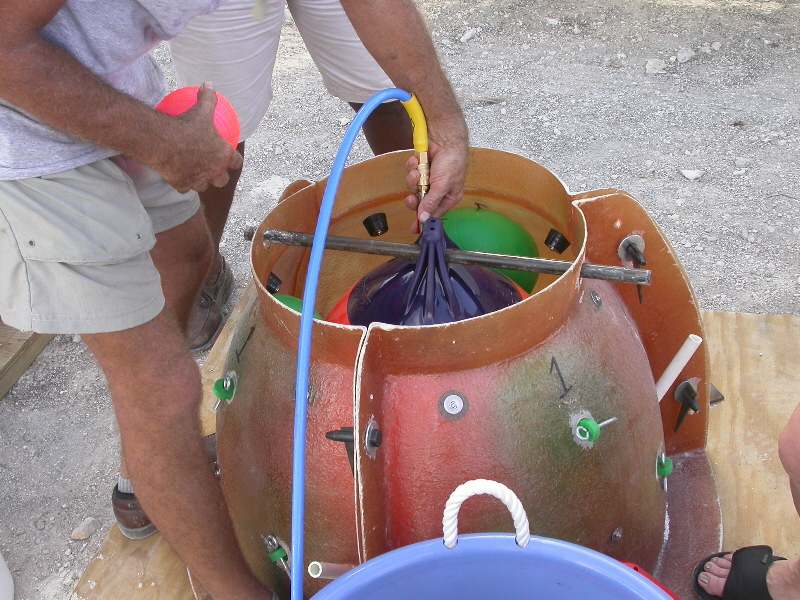
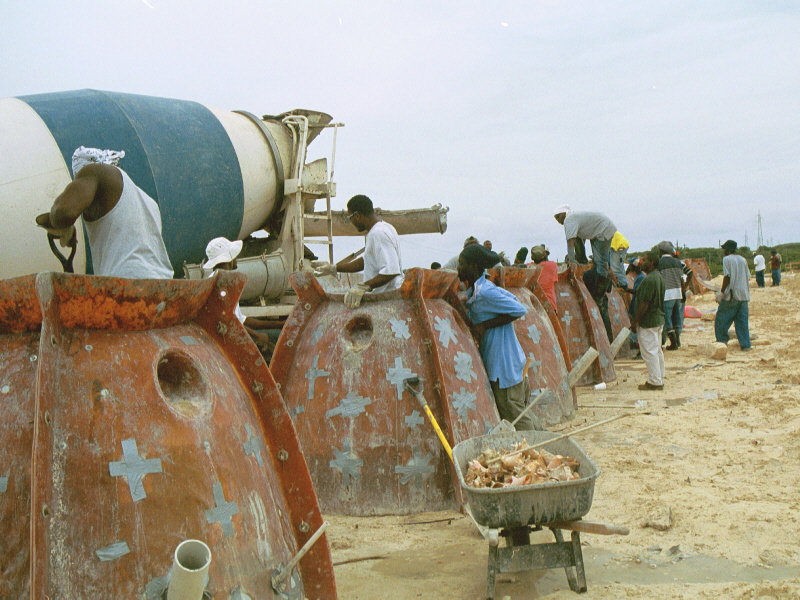
Casting 24/7 in over 40 complex mold systems using a
large variety of specialized techniques such as creating
special anchor holes, 'Layer Cake' style reef balls, and 8
different sizes of Reef Balls...building over 2000 Reef Balls
in 3 weeks!
More about the Construction and Deployment of
Reef Balls
Engineering to Restore a Beach
As part of the overall project plan, Stanford Development
Company Ltd. is going to fully restore the windward beach to
its original condition. About 50 years ago, non-beach
compatible sand from dredging operations was placed on Maiden
Island by the U.S. Navy. The dredging was for the
creation of a channel between Maiden Island and Antigua.
Therefore, Stanford Development Company Ltd. has removed all
the dredged sand and will recover it with natural beach
sand. The breakwater reef was specifically engineered to
lower the wave energy in the beach area so that the new
natural sand will remain stable. Stable sand means
clearer water, which is healthier for the coral. Many
engineers were involved directly or indirectly in the design
of the breakwater, including Greg Morris and Associates (Dr.
Greg Morris), Caribbean Oceanography Group Dr. Alfredo
Torruella),and Dr.
Lee Harris who is a consulting breakwater engineer and a
professor at the Florida Institute of Technology. The U.S.
Army, Corps of Engineers, Engineer Research
and Development
Center conducted extensive wave tank tests for a similar
planned Reef Ball submerged breakwater demonstration project
for Miami which had direct relevance to Maiden Island's
design.

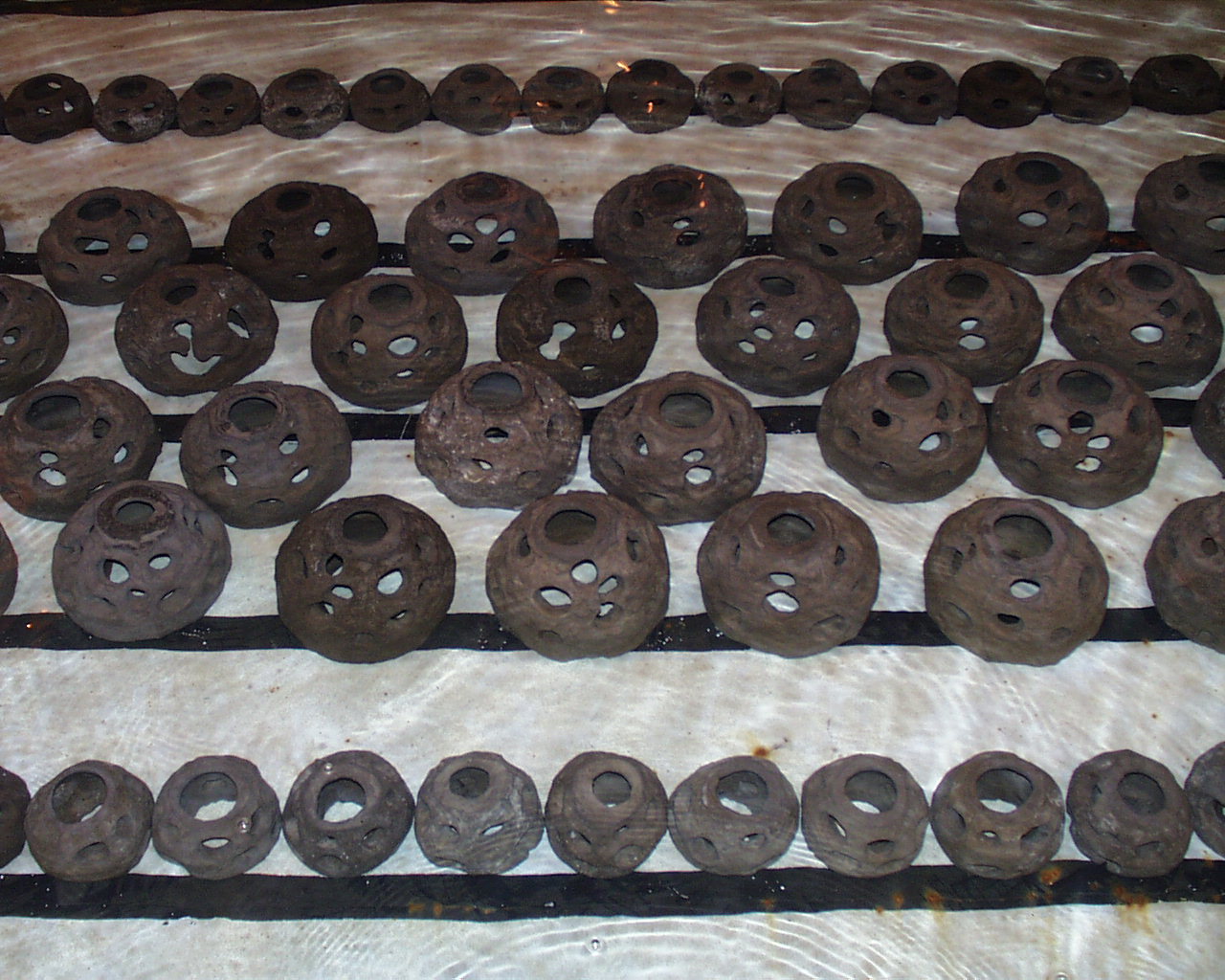
(Wave tank tests at the Army Corps Engineer Research
and Development
Center in Vicksburg,
Mississippi)
Six different anchoring solutions were used, depending on
the specific bottom type in the area to insure that the reef
balls will be stable during hurricanes events.
Incidentally, the engineers were impressed that they did not
need an underlayment / filter cloth or other support to keep
the Reef Balls from sinking into the sand....the Reef Balls
allowed the seagrass to survive and so the root system of the
seagrass acts as a biological underlayment / filter
cloth. No engineering details were overlooked, for
example, Stanford Development Company Ltd. used a 'Total
Station surveying method', which is accurate to within
centimeters. This methodology allowed accurate
placement so that existing natural corals would not be damaged
by the placement of the Reef Balls. A special mark had
to be established called the 'biological tide line', which is
the water level at which marine growth stops. The Reef
Balls were made of different sizes so that the top of each
Reef Ball would be exactly at the 'biological tide
line.' This makes for the most effective submerged
breakwater, and also maximizes the biological growing surfaces
for the new reef.

Engineering required tight
deployment tolerances and barge
crews ran
from first light to dusk every single day, rain or
shine.
More
about the Engineering of Reef Balls as Submerged Breakwaters
for Maiden Island
Unparalleled Success: The Bar Has Been Raised
The amazing success of this project is reflected in the
faces and comments of everyone that visits this special
place. Todd Barber, Chairman of the Reef Ball
Foundation said, "The SDC's Maiden Island Windward Reef
Project is the most sophisticated designed fringing breakwater
reef system on the planet....nothing even comes close.
If you had asked me 3 months ago if this would be possible I
would have said it would be extremely difficult...but
Stanford's people worked at a pace and with a sense of purpose
to create this reef unlike I have seen anywhere in the
world".

Todd Barber, CEO of the Reef
Ball Foundation plants an Elkhorn Coral (Cervicornis
palmata)
 Scott Glendining, Chief
Architect of the Maiden Island Project said, "Indeed, the Reef
Ball project is shaping up to be one of the finest successes
of our company. This is due to the expertise, commitment and
cooperation of all those involved. Thank you for all of your
help in bringing the world's largest Reef Ball project to
fruition. As SDC takes on a more regional presence, this
project will bode well as to the professional and
environmentally sensitive approach that can be taken in land
development and 'raise the bar' for all projects in the
region".
Scott Glendining, Chief
Architect of the Maiden Island Project said, "Indeed, the Reef
Ball project is shaping up to be one of the finest successes
of our company. This is due to the expertise, commitment and
cooperation of all those involved. Thank you for all of your
help in bringing the world's largest Reef Ball project to
fruition. As SDC takes on a more regional presence, this
project will bode well as to the professional and
environmentally sensitive approach that can be taken in land
development and 'raise the bar' for all projects in the
region".

R. Allen Stanford, head of the
Stanford Development Company Ltd. talks about his first
snorkel on the Reef Balls and how pleased he was with the
project.
Harold Hudson of the U.S. National Oceanic and Atmosphere
Administration (NOAA) who many know as 'The Reef Doctor' and
is a world known expert on coral reef restoration commented
that after reading the list of accomplishments and the time
frame in which it was done, the word 'amazing' seems
most appropriate to describe the new reef. The
output of the Reef Ball assembly line in particular would have
made Henry Ford proud. Watching the development of
(the reef) in the coming years should give (everyone) even
greater satisfaction.


Harold Hudson's 'Layer Cake' style
Reef Balls were used to create ledge and complex void habitat
types to make sure the reef was instantly balanced from a
structural perspective.
Bill Horn of the Florida Fish and Wildlife
Conservation Commission, Artificial Reef Program indicated
that he watched the handling of the corals closely since our
office must be involved to issue permits for a project like
this in Florida and I was extremely impressed with the health
of the coral and the whole process.

Bill Horn of the Florida Fish and Wildlife Conservation
Commission, Artificial Reef Program exams a rescued
coral
for coral disease before it is propagated into
hundreds of new corals.
Tom Maher of Marine Habitats, Inc. said, "Based upon a
decade of experience with artificial reefs around the world,
this reef represents the best and most complete natural reef
mimic for an artificial system than I have every
observed.
"
Tom Maher, left, teaches members of the Optimist Club of
St. Johns about
sea urchins.
The whole project cost less than traditional breakwaters,
which are rarely environmentally friendly, yet produced an end
result with far greater beauty, usefulness and environmental
sensitivity. Therefore, Stanford Development Company
Ltd. and the Reef Ball Foundation have raised the bar for
Caribbean developers. It's now possible to leave our
coral reefs in a better state after construction of
breakwaters. For more information about this project, go
to the Reef Ball Foundation's website at http://www.reefball.org/,
then click on the World Mapping System, then click on the
Caribbean Ocean, then click on the Reef Ball icon to the right
of Antigua.
>>>Go to How
17.5 Tons of Corals Were Rescued and 5000 Coral Colonies
Created in Antigua"
All photos on this page are available in High Resolution
Digital Format (4 mega-pixel resolution) and can be obtained
by contacting reefball@reefball.com.
There
are many other photos to choose from, by going to http://www.reefball.com/map/antigua.htm
you can see more pictures from this project. You may
freely copy and use this press release as long as it remains
unchanged. If you wish to write your own version, we
would be happy to set up interviews, provide digital photos or
even arrange a site visit. Use of photos requires
acknowledgement that the source is http://www.reefball.org/.
<Back to
World Map
(use browser back for one level back)
Copyright
1995 - 2003, RBDG,
Ltd. all rights
reserved. See brochure
page
footer for information on patents, copyrights, trademarks and
service marks referenced, but not indicated, on this page.
Other pages we maintain: Reef Ball Shared
Resources, Reef Ball
Foundation, La falda
Chairman
Reef Ball
Foundation, Inc.
6916 22nd Street West
Bradenton, FL 34207
reefball@reefball.comWeb site:
http://www.artificialreefs.org/
